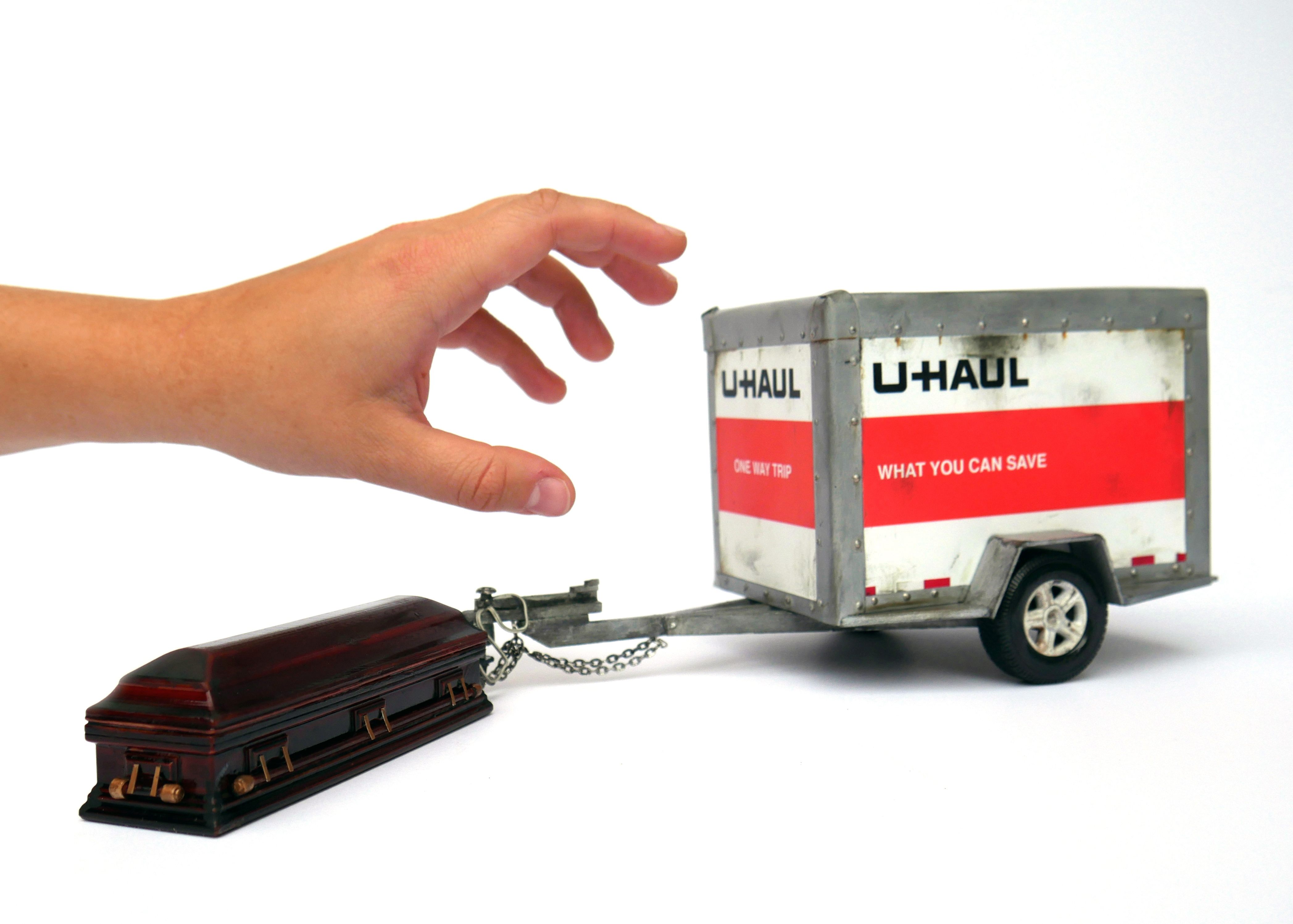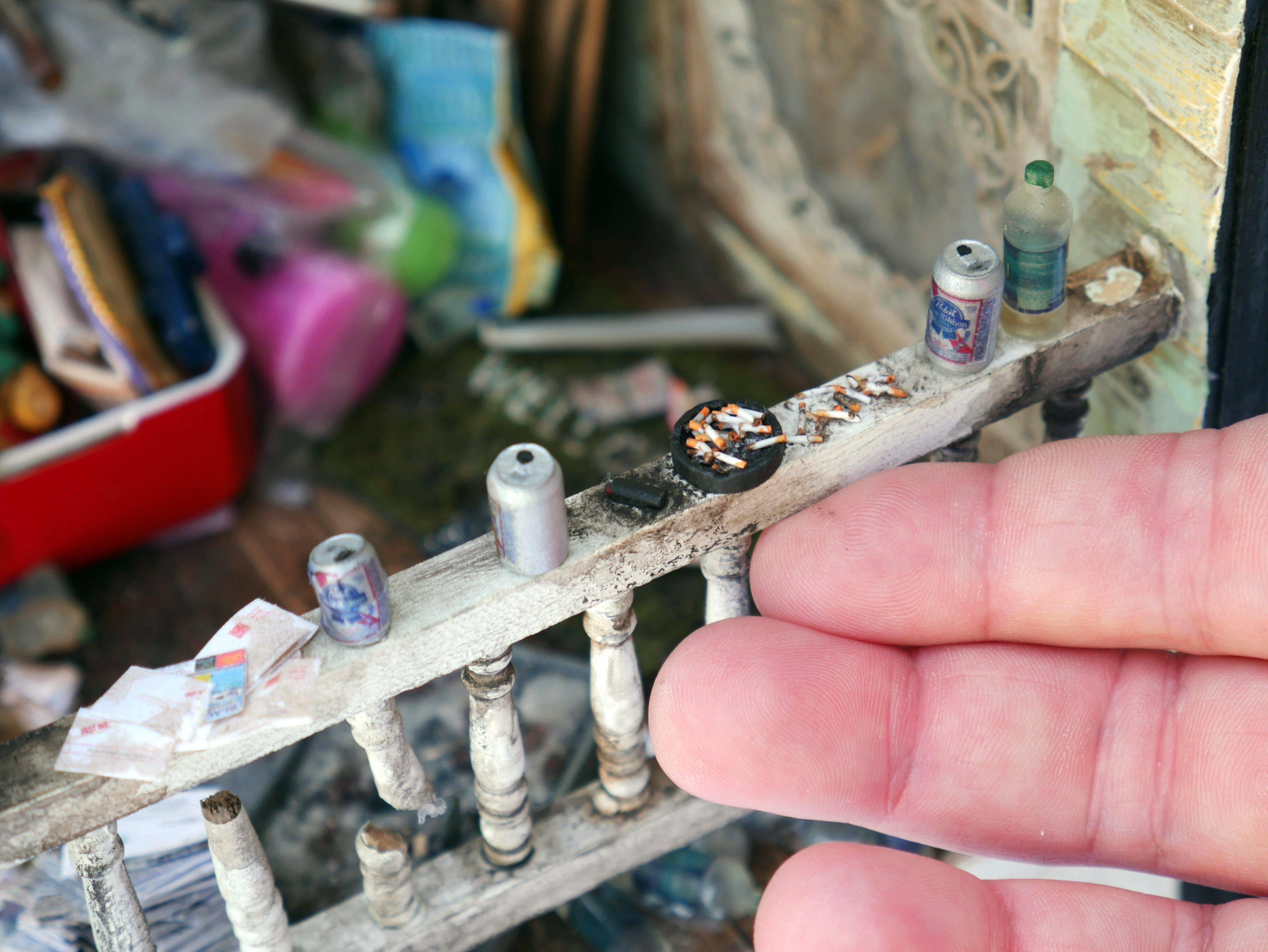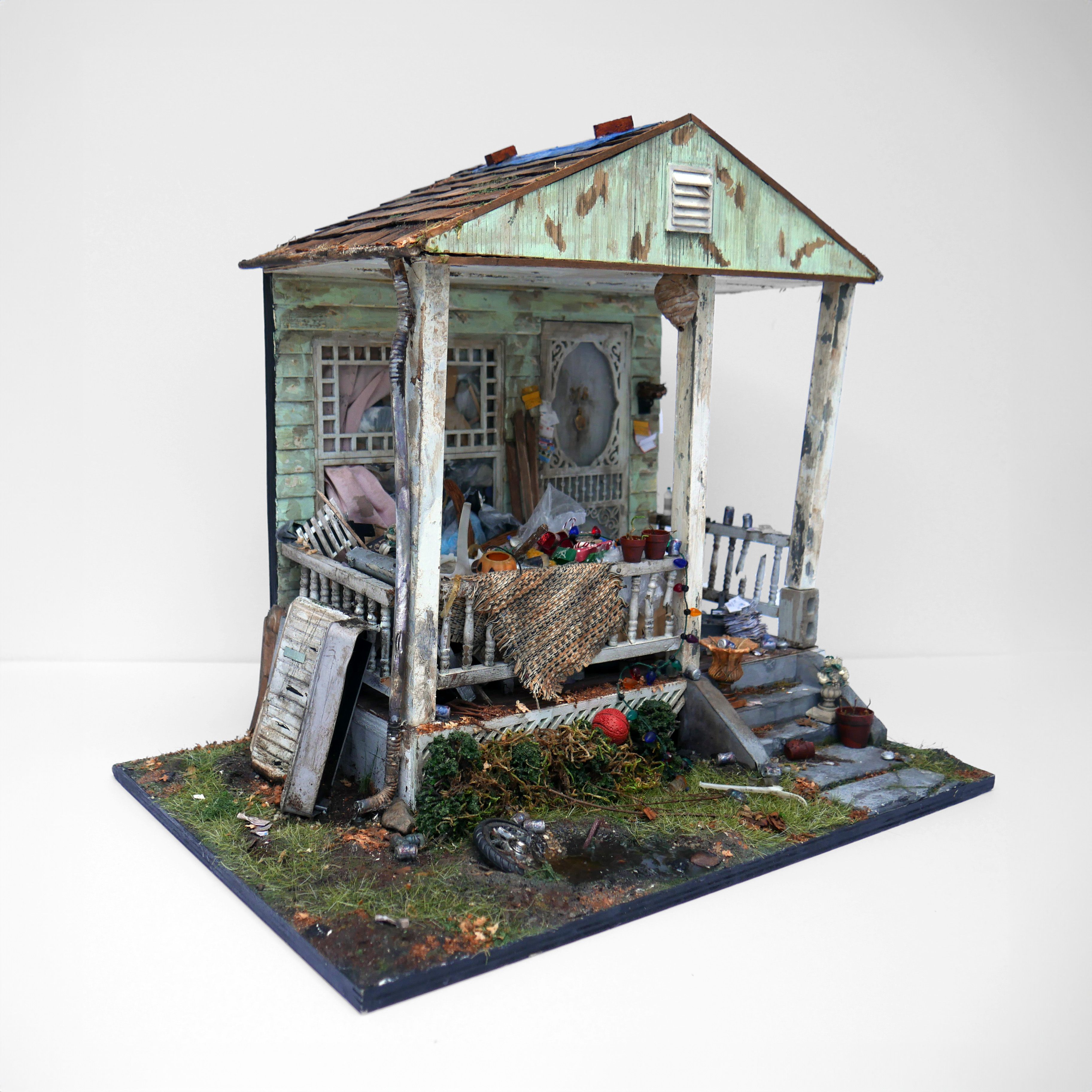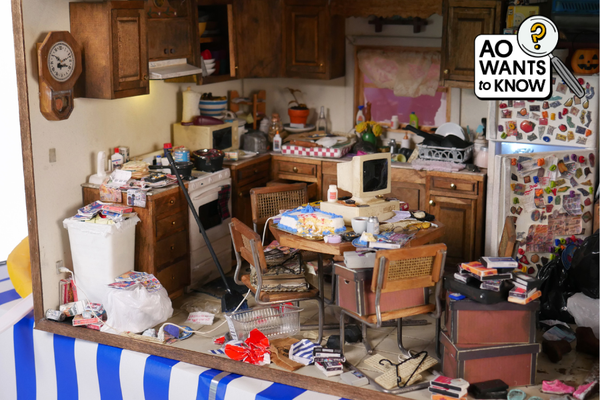AO Wants to Know is an ongoing interview series where we ask experts in extraordinary subjects to share their knowledge with us.
The kitchen is cluttered in every possible way. The sink is piled with dishes, full trash bags are stacked in the corner, a half-eaten sheet cake has been left out on the table beside a computer. There’s scarcely room for a person to move around, but there are no people here; only things. The sheer amount of objects of various sizes is even more remarkable for the fact that the entire room is only 18 by 12 by 11 inches. Entitled Glass Note, it’s not a real kitchen but a miniature, built to one-twelfth scale by artist Amanda Kelly.
The art of miniatures involves building tiny structures and objects to a precise scale and arranging them in carefully orchestrated dioramas. “[It’s] such a unique medium,” says Kelly. “And I think it’s a good medium for me personally to get my point across, because I can tell the story through the objects.” Kelly produced Glass Note in 2024 as part of a collection of works for her MFA thesis project at Radford University in Virginia. Her inspiration was the challenges faced by those living with compulsive hoarding disorder and the meanings we all assign to the objects we choose to hold on to. Asked why she chose a miniature scale, Kelly says, “That’s the intrigue of miniatures: It’s almost like you’re in a godlike position, where you’re looking down on the scene and analyzing it. If I had [made] this work life-size, it would tell a different story.”
While studying at the Fashion Institute of Technology in New York City, Kelly found herself pulled into the miniature community. She joined a local miniaturists group and attended dedicated conventions like Philadelphia Miniaturia. Noticing a lack of miniatures with a realistic, modern setting, Kelly was inspired to create them herself. “I do a little more of the grittier side of miniatures,” says Kelly. “There’s definitely a scale from the beautiful, pristine, Victorian miniatures—which I love and appreciate—and then there’s whatever I’m doing. Stuff has dirt on it, things are gross, there’s trash; it’s realism.”
Kelly teaches at Radford and Virginia Tech, and her artwork has been exhibited in galleries and museums around the U.S. She also crafts miniatures on commission, like a fingertip-sized cereal bowl for General Mills and a minute floral-patterned tea set for Netflix’s Bridgerton. Kelly explains that while some clients ask for custom miniatures to be sent to them, much of her commercial work involves creating social media content using the unique items and sets that she builds.
Creating realistic mini buildings and households requires Kelly to combine a range of techniques and tools. While much of her work is created directly by hand, she regularly applies technologies such as laser-cutting and 3D printing. “In my studio, I have every kind of material you can imagine,” she says. “Sometimes I wish I was just a painter, and I could just go to my studio and have my oil paint, and that’s it. But unfortunately, that’s just not miniatures.”
Kelly shared her fascination with building miniatures with Atlas Obscura, and explained the thoughtful storytelling behind her elaborate micro-worlds.
How did you first get into miniatures?
When I was growing up, my grandmother had a dollhouse that I would always play with. So I always knew about miniatures and dollhouses, but I didn’t know that it could be an art form; I thought it was just a hobby. Then in college, I watched a couple of YouTubers and started getting into the miniature community on Instagram. I bought my first dollhouse kit, and it kind of spiraled from there.
I started going to the miniature shows every year and getting connected with the community. The miniature community, as a whole, is quite large; not as miniature as the name would make you think! We do kind of all know each other, but [the community] is big in the sense that everyone does something different. There are people who focus on one thing, like making mini plants or mini food.
Do you get inspired by actual buildings or spaces that you see, or are you trying to create something fictional?
That’s something that I encountered a lot in my thesis, because I didn’t want to make exact replicas. Compulsive hoarding is a hard topic, and I didn’t want to make anyone upset, so I tried to change things [from reference photos] as much as I could, while still getting my point across.
I like to call it an assemblage or collage of different inspirations. For Glass Note, it’s a kitchen scene, and I had the idea in mind of setting it in the late ’90s. So I looked at a lot of ’90s and early 2000s kitchens; the style of the cabinets and the way the sinks and the counters and the stoves look. Just taking inspiration from multiple sources. I’m not an architect; I’m not creating architectural models, I’m creating art, and art doesn’t necessarily have to be a direct replica of something.

How important is it to imagine the story of the space that you’re building?
I think having a story behind art is really important for giving more context to a piece. I don’t think it’s always necessary, but specifically for my MFA work, which is the largest body of work I’ve ever made, there was definitely a narrative thread, and each piece has its own narrative. Some of them are based on my experiences, and some are just based on general experiences that I’ve read about, or even things I’ve seen in local neighborhoods.
When I was in my MFA program, I really studied object theory and putting meanings on objects. “Why do we care about objects?” was the crux of my whole argument, and then taking it to the next level: “Why do hoarders care about things?” It’s a different care there. The way that [hoarders] approach objects is totally different than how people without a compulsive disorder have treated objects. So, how do [hoarders] treat objects? How does everyone look at objects? Why do we keep little trinkets? Why do we like buying things? Every piece of mine was answering some part of that. My U-Haul piece was about how you can’t take objects with you after you die; my avalanche piece was about, “What if somebody has a shopping addiction? Where does that come from?”
You usually don’t include human figures in your work. Is that typical of artists in the miniatures community?
I would say it’s half and half. A lot of people are doll collectors or doll-makers in the miniature community, but they’re kind of a subset under the umbrella of miniatures. And it’s very common in the miniature community to just sell objects; really, the focus of the community as a whole is the objects. Personally, I don’t like having dolls or figures in a scene, because I feel like it takes the focus away.
If there’s a coffee mug half drunk on the coffee table, what does that say about the person that was just there? Why do they have a pile of laundry on the floor? I really like adding details like that, where the more you look at it, the more questions you have. Especially with my compulsive hoarding scenes. The first piece that I ever made for this series was Hoarder’s Porch. And on the porch, there are many different things. There’s an ashtray full of cigarettes, there are beer cans, but there are also Christmas decorations and children’s toys, and eviction notices on the door. You notice these things, and you build a story in your mind about what may be happening with the people who live here.

Do you have to learn a lot of different skills to make miniatures? And do you have to turn to other artists to produce certain things for you?
I feel like this medium is perfect [for me] because I always have a new hobby. It is very interdisciplinary. I would say you have to know how to paint, how to sculpt, and how to work with fabric, wood, and leather. I learned how to do a lot because I’ve had to make some things that were very specific.
A lot of my work has these scenes that are just exploding with [small] objects. If I made every single object myself, I’d probably still be in my MFA program, making one thing. So sometimes I source things and buy them directly from artisans, but it’s not as common. A lot of the items in my pieces, either I made them from scratch, I 3D modeled and 3D printed them, or they are laser cut from files that I made or maybe files that I bought. It depends on what it is, but I would say my work is probably 90 percent scratch-built, including 3D printing in that process. The rest is just items that I’ve found, like mass-produced items that I repaint or I add stuff to.

Has new technology changed the way that you work over time?
New technology doesn’t come fast to the traditional dollhouse and miniature community; 3D printing is a great example, because when I started 3D printing, I was one of the only miniaturists doing it. I felt like a lot of people were wary about the technology, but for me, I really love the boundaries that I can push with it.
Of course, I could sculpt every little thing myself by hand, and I have in the past when I didn’t have a 3D printer. If you’re making one item or multiple items of one thing to sell, that’s fine, but I’m making multiple items of all sorts of things. And for me, 3D printing just takes a lot of the headache out of that. Instead of sitting there sculpting one little thing for eight hours, I could do it on my computer and have them printing while I’m working on something else.
Do you have a favorite commission that you have worked on?
Oh my gosh, I have a lot of favorites, but two years ago I worked with Xbox and Obsidian Studios to make a miniature for the beta-release of Grounded. It’s a game where you’re shrunk down to the size of an ant. I loved that concept, and when I played it, I was like, “This is the coolest thing ever!” So I got to make a miniature based on that. They sent us the 3D printing assets for the game so we could print the characters, which is something I’m not used to doing, but it was a lot of fun just painting the little characters and making a little base camp.
This interview has been edited and condensed for length and clarity.
